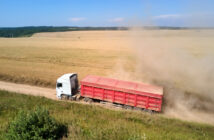The average value of arable land in England has risen to a record of £10,800/acre, with strong interest from private and institutional investors pushing up prices.
Analysis of Strutt & Parker’s Farmland Database, which records the details of all farms, estates and blocks of publicly marketed farmland over 100 acres in size, shows that private and institutional investors bought 33% of all the farms sold in 2022 – the highest level for at least a decade.
Matthew Sudlow, head of Estates & Farm Agency for Strutt & Parker, says: “Over the past 12 months, private and institutional investors have played a growing role in the farmland market. In total, they bought more than half of the agricultural land publicly marketed in England during 2022, demonstrating that at times of economic uncertainty and high inflation land does tend to be seen as a haven for capital.”
Analysis shows that the average value of arable land is currently £10,800/acre, which is £200/acre more than Strutt & Parker reported at the end of 2022 and 15% higher than a year ago.
The average value of pasture land is £8,500 which is 13% higher than 12 months ago.
The data highlights that nearly 70% of arable land in England sold for over £10,000/acre in 2022, compared to 33% in 2021. However, the range in prices achieved can still be wide with the highest value recorded in 2022 being £21,500/acre and the lowest being £6,000/acre.
84% of farms that exchanged in 2022 sold at, or over, their guide price, the highest proportion since 2000. Demand has been particularly strong for cereals farms.
Demand outstripping supply
“The market continues to be highly competitive, with demand outstripping supply,” says Mr Sudlow. “Just 4,300 acres was brought to the open market during the first three months of the year which is the smallest amount for the past 20 years. However, we do expect the market to return to more normal levels in the spring and summer as we are getting more enquiries and instructions than we have seen for some time.”
Looking forward, Mr Sudlow says even if supply increases it is unlikely to change the balance in the market.
“We are seeing no signs of demand for farmland weakening. Investors are continuing to look for tangible assets that are likely to appreciate and there is still strong demand from buyers – including farmers – looking to roll-over capital gains. Meanwhile, lifestyle choices are continuing to be evaluated, with farms and estates having an enduring appeal. Given this outlook, we expect prices for both arable and pasture land to remain at their current record levels, and possibly increase further.”




